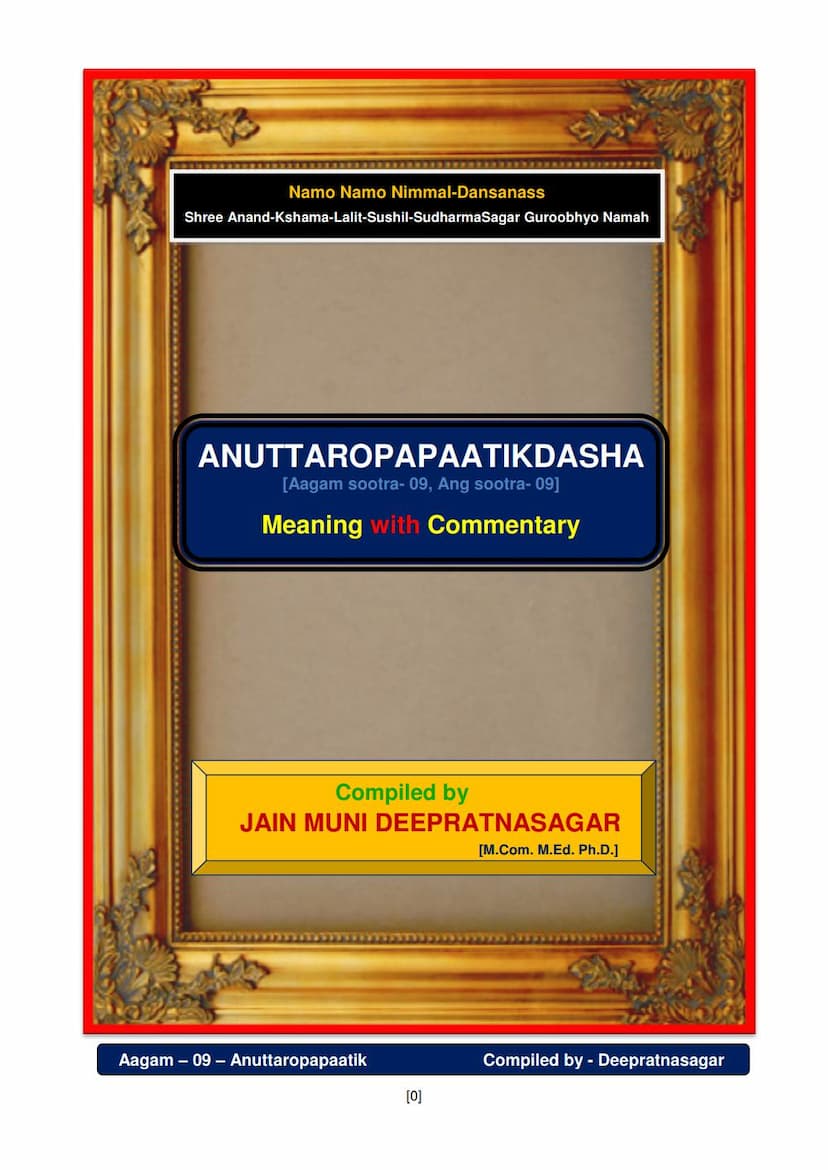Agam 09 Ang 09 Anuttaropapatikdasha Sutra English Translation
Added to library: September 1, 2025

Summary
The provided text is an English translation and commentary of the Jain Agam Sutra titled Anuttaropapatikdasha. This work, compiled by Jain Muni Deepratnasagar, is the ninth Anga (limb) of the Jain scriptures.
The Anuttaropapatikdasha Sutra focuses on the lives of individuals who, through intense austerities and virtuous conduct, have progressed significantly in their spiritual journey. While they have not yet attained full liberation (Moksha), they are reborn in the highest celestial realms known as Anuttar Vimanas. These are abodes of extremely powerful and pure celestial beings.
The text is structured into three Vargs (parts), each containing several chapters (Adhyayans).
Key Themes and Content:
- The Nature of Anuttaropapatikdasha: The Sutra describes individuals who have to some extent destroyed their past karmas through exemplary conduct and austerities, but not completely. This incomplete destruction leads to rebirth in the elevated Anuttar Vimanas rather than immediate liberation.
- The Three Vargs:
- Varg 1: This part consists of ten chapters. Each chapter narrates the life story of a spiritual seeker. Specifically, this Varg details the lives of ten sons of King Shrenik and Queen Dharini. These princes renounced worldly pleasures and embraced asceticism under Bhagavan Mahavir. They undertook rigorous austerities, purified their souls, and after their lifespan, were reborn in different Anuttar Vimanas (Vijay, Vaijayant, Jayant, Aparajit, and Sarvarth Siddh). The first chapter details the life of Jali Kumar, while subsequent chapters cover other princes like Mayali Kumar, Uvayali Kumar, Purushsen Kumar, Varishen Kumar, Deerghdant Kumar, Lashtdant Kumar, Vehalla Kumar, Vehayas Kumar, and Abhay Kumar. The text also highlights potential scriptural discussions regarding individuals with similar names being distinct individuals.
- Varg 2: This part contains thirteen chapters. It focuses on the austerities and spiritual practices of thirteen great monks, all of whom were also sons of King Shrenik and Queen Dharini. Similar to the first Varg, these individuals renounced their worldly lives, accepted initiation from Bhagavan Mahavir, and engaged in severe austerities. They too were reborn in various Anuttar Vimanas after completing their earthly lives. The chapters detail figures like Deerghsen, Mahasen, Lashtdant, Goodhdant, Shuddhadant, Halla, Drum, Drumsen, Mahadrumsen, Simha, Simhasen, Mahasimhasen, and Punyasen. The text notes that the austerity period for these individuals was often sixteen years, with their Samlekhana (final spiritual preparation before death) lasting one month.
- Varg 3: This part comprises ten chapters. It provides a detailed account of ten great ascetics engaged in self-realization. The first chapter, "Dhanya Kumar," is particularly significant for its vivid description of Dhanya's spiritual awakening. Dhanya, a prince brought up in extreme luxury, renounced his opulent life after a single discourse from Bhagavan Mahavir. The text vividly portrays the severe physical toll his austerities took on his body, using numerous similes to illustrate his emaciated state. Dhanya's disciplined fasting regimen (two-day fasts with Ayambil breaking) and his unwavering commitment to acceptance of even tasteless and rejected food ("Sansrisht" and "Ujjhit" food) are highlighted as examples of extreme detachment. The remaining chapters in this Varg briefly describe other ascetics like Sunakshatra, Rishidas, Pellak, Ramputra, Chandrik, Prishtimatrik, Pedhalputra, Pottilla, and Vehalla. Many of these individuals also attained rebirth in Sarvarth Siddh Viman.
- Commentary and Cross-References: The compilation includes extensive commentary, drawing parallels and cross-references to other Jain scriptures such as Bhagavatisutra, Antakrud-dasha, and Jnata-Dharma-katha. This helps in understanding the context and the detailed descriptions of practices and lives.
- Spiritual Practices and Terminology: The text elucidates specific Jain ascetic practices like Samlekhana (a ritual fast unto death, undertaken with equanimity) and Ayambil (a specific type of controlled diet). It also defines terms related to fasting periods like Chhattha Tap and explains the concept of Palyopam and Sagaropam as units of immense time, crucial for understanding celestial lifespans.
- The Ultimate Goal: Throughout the narratives, the ultimate aim remains liberation from the cycle of birth and death. The individuals described in Anuttaropapatikdasha are on a path towards this goal, and their rebirth in Anuttar Vimanas is a significant step in their spiritual evolution, with a guaranteed future rebirth in Mahavideh to attain final liberation.
In essence, the Anuttaropapatikdasha Sutra serves as an inspiring testament to the power of detachment, rigorous asceticism, and unwavering devotion in the Jain path towards spiritual advancement, leading to highly elevated states of existence before the final attainment of Moksha.